 |
|
(Image: Osram) |
Human-Centric Lighting
Light influences our lives in many ways including our health, moods, productivity, concentration, sleep cycles, decision making and emotions. With the adoption of smart lighting and IoT, lighting characteristics such as color, intensity and timing can automatically adjust to meet the needs of occupants. For example, in this article by Digital Lumens (now OSRAM), the author states, “In your kids’ elementary school, biometric sensors will track students’ alertness, subtly shifting spectrum to automatically boost their focus any time it starts to wane.”
Chad Groshart, IALD, LEED AP BD+C, and WELL Faculty/AP is directly involved with Human Centric Lighting (HCL) on a daily basis. “Human Centric Lighting is a significant trend with interest and adoption rates growing, and the latest controls technologies are making it easier to implement” says Groshart. He states, “The International WELL Building Standard® has been a catalyst behind the growing interest in HCL.” The WELL Building Standard® is a performance-based system for measuring, certifying, and monitoring features of the built environment that impact human health and wellbeing. It is third-party certified by Green Business Certification Inc. (GBCI) which administers the LEED certification program and the LEED professional credentialing program.
Smart Lighting Systems Enable IoT Applications
Lighting is ubiquitous and every fixture has easy and reliable access to power. Add sensors, LED technology and connectivity and a lighting system changes the way we view and interact within our workspace. An intelligent, sensor-laden, connected lighting system becomes a data-driven network that can be tied into an automated Building Management System (BMS).
Future-minded building owners and facilities managers will see each light point as a data node and likely will be the early adopters of emerging Smart Building and IoT applications. The connected lighting control system they choose today for lighting and energy management will become the infrastructure that enables these applications.
Sensors, Sensors and More Sensors
It’s still a bit of the ‘Wild West’ with respect to understanding what IoT applications will be launched and what sensor data will be required for those ‘must have’ applications. Preparing a building’s infrastructure for the unknown has some facility executives hedging their bets by installing an increased number of sensor technologies within their connected light management systems.
In addition to daylight and occupancy, sensors for relative humidity, particulate matter, environmental pollutants and more are being requested by forward-thinking facility managers. There is a growing sense (no pun intended) that ‘more is better’. “It’s no surprise that light fixtures are being seen as an ideal deployment platform for more than daylight and occupancy sensors”, says Groshart. “Although no one knows the exact potential of each of these types of sensors, there’s a general agreement among facility managers of high end design projects in particular, that the potential is there and you don’t want to be left behind when reality hits.”
Simplify Daylight Harvesting
Daylight harvesting is not a new lighting control strategy, nor is the loud cry from the market to simplify the daylighting control commissioning process. ASHRAE 90.1-2016 has tightened automatic daylight-responsive control requirements for side-lighting and top-lighting, adding more situations where daylighting will be required, and the LEED rating system for certification includes up to 3 credits for proper daylighting.
With the emphasis on simplicity of installation, expect to address daylight harvesting more easily with new lighting control systems that offer easy set up and commissioning tools and support. The desire to bring as much natural light into a space as possible, meet code and reap the associated energy savings benefits will become easier.
Daylight harvesting uses a lighting control system to dim artificial lighting in response to changing daylight availability. Automated lighting control systems measure the amount of natural light in a space using light sensors, and dim or switch off artificial light levels when sufficient ambient light is present. A consistent and optimum level of light is realized while simultaneously reducing energy consumption.
Energy Consumption and Code Compliance
Although new energy codes have been driving the digitization of lighting for the last 10 years, we could not drop energy consumption from our 2018 trends list. In fact, energy consumption continues to influence many lighting design decisions particularly as codes get updated and become tighter. Many in the industry anticipate stricter rules in the 2019 iteration of Title 24 that will go into effect on January 1, 2020, and facilities managers outside California would do well to pay attention to this update as the energy mandate could spread to other states.
Although the energy budget is still a key parameter of design, leading experts believe recent code stipulations should not keep anyone from doing good lighting design. In fact, they cite that ASHRAE 90.1 has a 1 watt/sq. ft. decorative allowance on top of the baseline allowance which should enable a good lighting designer to balance the desires of the client with energy code stipulations.












